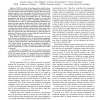Free Online Productivity Tools
i2Speak
i2Symbol
i2OCR
iTex2Img
iWeb2Print
iWeb2Shot
i2Type
iPdf2Split
iPdf2Merge
i2Bopomofo
i2Arabic
i2Style
i2Image
i2PDF
iLatex2Rtf
Sci2ools
PIMRC
2015
IEEE
2015
IEEE
Obstacle avoidance cell discovery using mm-waves directive antennas in 5G networks
—With the advent of next-generation mobile devices, wireless networks must be upgraded to fill the gap between huge user data demands and scarce channel capacity. Mm-waves technologies appear as the key-enabler for the future 5G networks design, exhibiting large bandwidth availability and high data rate. As counterpart, the small wave-length incurs in a harsh signal propagation that limits the transmission range. To overcome this limitation, array of antennas with a relatively high number of small elements are used to exploit beamforming techniques that greatly increase antenna directionality both at base station and user terminal. These very narrow beams are used during data transfer and tracking techniques dynamically adapt the direction according to terminal mobility. During cell discovery when initial synchronization must be acquired, however, directionality can delay the process since the best direction to point the beam is unknown. All space must be scanned using the tradeoff ...
| Added | 16 Apr 2016 |
| Updated | 16 Apr 2016 |
| Type | Journal |
| Year | 2015 |
| Where | PIMRC |
| Authors | Antonio Capone, Ilario Filippini, Vincenzo Sciancalepore, Denny Tremolada |
Comments (0)

